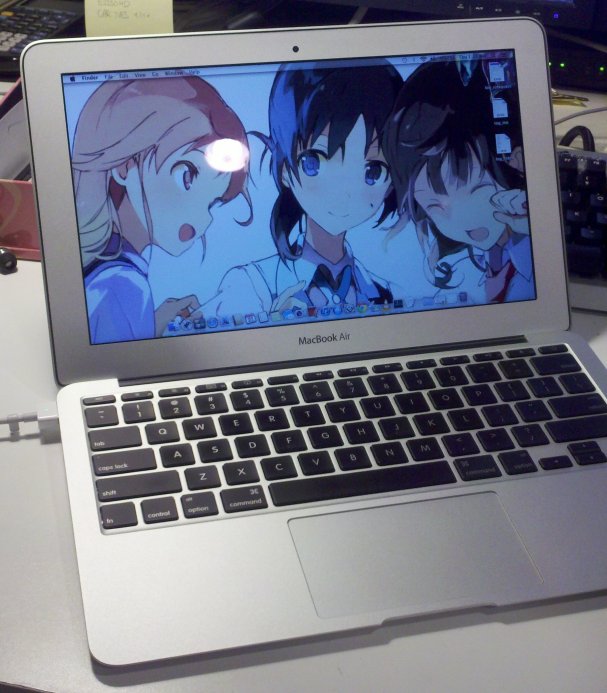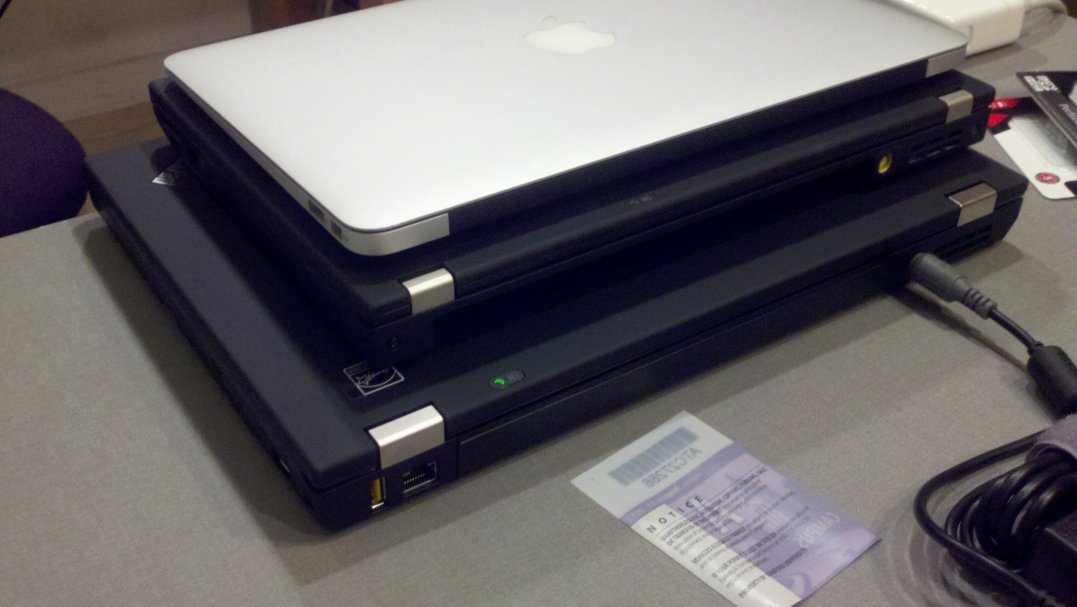The 2010 11-inch Air is a laptop I liked so much that I bought it twice, even though I couldn’t find a use for it either time.

I’ve liked the MBA 11 since launch because I don’t believe that there is, by a fairly long shot, a comparable “conventional” equivalent. It’s basically right between the top end of netbooks and the bottom end of traditional ultraportables. This is a fairly vague and messy kind of comparison to make, especially given that the MBA line has just been refreshed, but I’ll try to get across how I see it.
The first time I bought it in August of 2011, I paid about $600. At that time, you could get a decent netbook for maybe half or two-thirds of the cost, but that netbook would probably have been thicker and heavier as well. You’d also have a super slow first or second generation Atom. On the ultraportable side, there were things like the low-end $400 Dell Vostro V130, the $650 ThinkPad x220, or the very high-end $1000 Samsung 9 Series (these are all used prices).
These are all admittedly, including the already last-gen V130, much faster than the Penryn-based 2010 MBA 11, but none of them come close to size and weight.
| Machine | Width | Depth | Thickness | Weight |
|---|---|---|---|---|
| 2010 MBA 11 | 11.8″ | 7.56″ | 0.68″ | 2.3lbs |
| Vostro V130 | 13″ | 9.06″ | 0.78″ | 3.6lbs |
| ThinkPad X220 | 12″ | 8.9″ | 1.5(!)” | NA |
| 9 Series | 12.9″ | 8.9″ | 0.64″ | 2.88lbs |
| ThinkPad X200s | 11.6″ | 8.3″ | 1.1″ | 2.6lbs |
I threw the ThinkPad X200s on there because at $500, it actually seemed like a much closer competitor. It also had the option for a WXGA+ (1440 x 900) screen, most likely an expensive option, but a nod back to the days of SXGA+ in an x60(t) or x61(t), and much appreciated.
But like I said, I couldn’t find a use for it and sold it.
Now a year later, I’ve gotten the itch again, and this space still seems to be void of comparable conventional alternatives (conventional meaning Windows). If you are looking for the lightest/thinnest/smallest full-featured (by that I really mean “non-netbook”) ultraportable, the 11-inch MBA is basically still it. There was the comparable SB-based 11-inch Samsung Series 9, which seems to have been close to vaporware and now seems to be official EoL, and there is the comparable Asus UX21A/E, which seems to be very difficult to buy, and ever the more so if you want one with the 1080p screen. And that 1080p screen is the only reason I’d buy it over the MBA. These latter machines (used and if you can find them, of course) are also more expensive than the first-gen 11-inch MBA, and I don’t know anything about the fan profiles, which is important to me.
Even with the 3-cell battery, my x220 tablet weighs a hefty 3.8lbs. With the 6-Cell battery, the vanilla x220 is lighter, at 3.3lbs. The 11-inch MBA, as weighed on my own scale hits the exact advertised weight of 2.3lbs. It’s much harder to measure thickness accurately, but I’m pretty sure the MBA is very close to be half as thick as the two ThinkPads. The decrease in footprint size is probably proportional to the decrease in nominal screen size. The following picture shows the MBA on top of the x220 on top of a T430 (which is basically “regular” laptop sized).

This is still the first-gen 11-inch MBA from 2010, which still costs all of $550. It’s pretty dated spec-wise, but it’s been a long time since that has mattered. The SU9400 with 2GB is more than enough for anything that I’m going to do with the machine, and the stock SSD makes things plenty fast as well. You can even do some basic gaming on the 320M and by that I mean fluid low-res, low-quality SC2 or TF2.
Apple build quality is impeccable as usual (though this has not always been the case; I’m looking at you plastic, non-unibody Core Duo MacBook) and everything fits together nicely without complaint. The metal body also wears really well; even on this relatively old machine you don’t see any shine or residue accumulating on the palmrest. The keys wear a bit worse, but because they don’t have much texture in the first place, I think said wear is less noticeable. I’m a little upset that they don’t have an SD card reader, but I guess it’s just one of the sacrifices you have to make going to this form factor.
I didn’t kick off this writeup with my usual ranting about power and noise because it’s basically a given that Apple does both very well, and I really appreciate that. Idle power is something in the realm of four watts (in comparison you can get about 5.5 for a typical SB ThinkPad) for a three generation old platform with what is effectively a discrete GPU, and I can get the advertised 4 to 5 hours of practical run time without even trying. I actually think the fan is running close to all the time, but I have to hold my ear against the underside to hear anything at all at idle, which is really quite acceptable. Under load the fan does get pretty loud, but it’s still not loud enough for me top hear over my YouTube video, and Apple throttles it back very aggressively when the CPU is unloaded.
In the end though, I’m still not sure what the use case is. The idea was to have the t430, docked, the x220 tablet for any tablet requirements, and the MBA 11 if I have to carry a laptop for a long time, but I think it’s a bit excessive having three laptops. I tried to get my dad to timeshare the MBA with me (and thus pay some of the price), but he’s managing to get by without a laptop and just his DTR and iPhone. This is still one of the best laptops of all time in my opinion, and I still don’t really have a use for it.
An aside on the MBA 13:
Some people have asked me about the 13, and I don’t think the 13 was ever as unique as the 11. Look at what was already available in the Windows space when the first generation 13 came out in 2008:
| MACHINE | WIDTH | DEPTH | THICKNESS | WEIGHT |
|---|---|---|---|---|
| 2008 MBA 13 | 12.8″ | 8.94″ | 0.76″ | 3lbs |
| HP Envy 133 | 12.7″ | 9.0″ | 0.7″ | 3.4lbs |
| ThinkPad X300 | 12.4″ | 9.1″ | 0.92″ | 2.93lbs |
(to this day I really like the design of the 133; I wish the modern HP Envy lineup had the same ID)
Pricing is a little murky here: The first MBA 13 started at $1800, the x300 at $2500, and the 133 at $2100. Nonetheless, included with the x300, in an age where such a thing easily cost more than $500, was a first-gen Samsung SSD, and a equally rare and expensive thin optical drive… it was arguably a better value than the MBA, and most certainly the 133, both of which shipped with slow, small hard drives in the base configuration. Battery lives were comparable across the three original super-slim ultraportables.
Even today, the 0.68 x 12.8 x 8.94, 2.96lb MBA 13 (the newest one to boot) goes toe to toe with comparable Samsung 9 Series in basically all aspects; heck it’s even a little heavier and I think a little more expensive second hand. My point is that there have and are plenty of comparable “conventional” alternatives in the 13-inch space, but not in the 11-inch space, and that’s what makes the 11 unique.